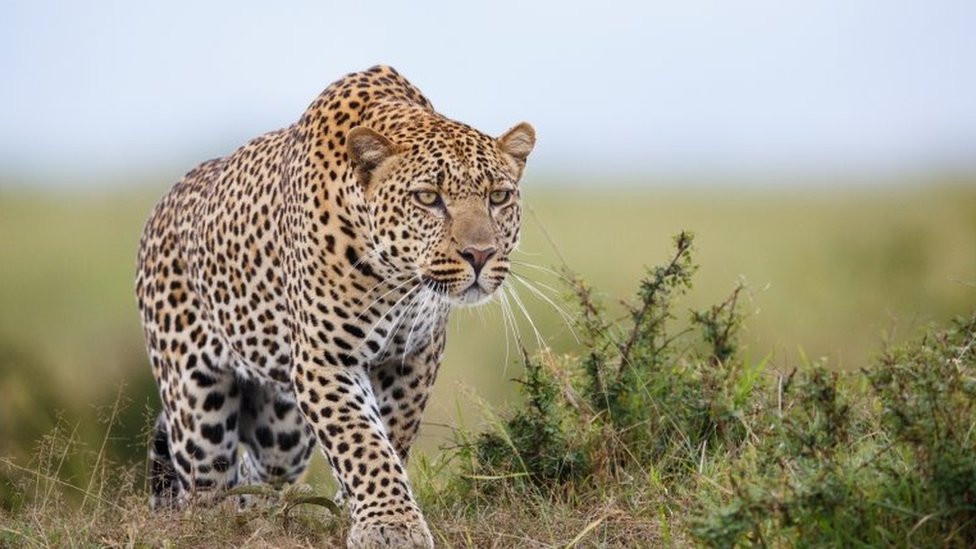The leopard (Panthera pardus) is a medium to large-sized feline found across Africa and Asia. Renowned for its agility, stealth, and iconic spotted coat, the leopard is a master predator in its habitat. Playing a crucial role as a top predator in the ecosystem, the leopard is both a symbol of strength and an enigmatic subject of fascination.
Kingdom: Animalia
Phylum: Chordata
Class: Mammalia
Order: Carnivora
Family: Felidae
Genus: Panthera
Species: Panthera pardus
Leopards share their genus with lions, tigers, and jaguars, but they are smaller and uniquely adapted for climbing and solitary living.

Body Structure:
Leopards measure 90–160 cm in body length, with a tail length of 60–110 cm, and weigh between 30–90 kg. Males are generally larger than females.
Their muscular limbs and body provide exceptional strength and agility.
Coat and Spots:
Leopards have a yellowish coat with distinctive rosette-shaped spots, with variations depending on the region.
The pattern provides excellent camouflage in diverse environments.
Facial Features:
Leopards have relatively small heads with round ears and striking golden or greenish eyes, optimized for night vision.
Leopards are highly solitary animals, marked by strong territorial behavior. They mark their boundaries with scent markings and scratches on trees.
Leopards are among the most adaptable big cats, thriving in:
Tropical Rainforests: Such as the Congo Basin in Africa and Indonesia in Asia.
Savannas: Like the Serengeti in Africa.
Mountains: Such as the Caucasus in Central Asia.
Desert Margins: Such as the Arabian Desert.
African Leopards: Found widely across sub-Saharan Africa, from grasslands to forests.
Asian Leopards: Range from India, China, and Sri Lanka to parts of the Middle East.
Endangered Subspecies:
The Arabian Leopard (Panthera pardus nimr) and the Amur Leopard (Panthera pardus orientalis) are critically endangered.
Leopards prefer areas with dense vegetation for cover. They are also frequently found near human settlements, showcasing their remarkable adaptability.
Leopards are apex predators, excelling in stealth and ambush tactics:
Ambush Predation: They rely on camouflage to approach prey unnoticed and then pounce with lethal precision.
Climbing Ability: Leopards are adept climbers, often dragging their prey into trees to avoid scavengers.
Burst Speed: They can sprint up to 60 km/h for short distances, using bursts of speed to capture prey.
Leopards are opportunistic carnivores and have a broad diet, including:
Medium-Sized Mammals: Such as antelopes, deer, and monkeys.
Birds and Reptiles: Leopards will prey on birds and lizards when larger prey is scarce.
Livestock: In human-dominated landscapes, they may prey on goats and sheep.
A unique behavior of leopards is dragging prey into trees to store it, protecting their meals from scavengers like hyenas.
Leopards do not have a fixed breeding season, and reproduction can occur year-round:
Mating Period: Mating lasts 4–5 days, after which the male and female separate.
Gestation Period: Females carry their young for 90–105 days.
Litter Size: Typically, 1–4 cubs are born per litter.
Early Life:
Cubs are born blind, weighing around 500–600 grams.
They open their eyes after two weeks and start following their mothers by three months.
Independence:
Cubs remain with their mothers for 12–18 months before setting out to establish their own territories.
In the wild, leopards live an average of 12–15 years, while those in captivity can live over 20 years.
Large Carnivores:
Threats to Cubs:
Leopard cubs are particularly vulnerable to predation by lions and other large predators.
Camouflage: Leopards blend seamlessly with their surroundings to avoid detection.
Tree Refuge: Trees provide a safe haven from ground-based predators.
Habitat Loss: Deforestation and agricultural expansion are major challenges.
Poaching: Leopards are hunted for their beautiful pelts and bones.
Leopards control populations of herbivores and smaller predators, maintaining ecological balance.
By consuming prey that feeds on plants, leopards indirectly aid in seed dispersal through the digestive systems of their prey.
Leopard populations often reflect the health of their habitats, making them critical for biodiversity studies.
African Tribes: Leopards symbolize strength and cunning, often depicted in tribal art and folklore.
Asian Mythology: Leopards are revered for their speed and agility, featuring prominently in Chinese and Indian legends.
According to the IUCN, leopards are classified as "Vulnerable," with some subspecies critically endangered.
Protected Areas: National parks like South Africa's Kruger National Park and India's Ranthambore Tiger Reserve are crucial for leopard conservation.
International Treaties: CITES regulates the trade of leopard skins and other body parts.
Community Awareness: Education programs help reduce human-leopard conflict and foster coexistence.
Nine recognized subspecies of leopards exist, with key ones including:
African Leopard (Panthera pardus pardus)
Indian Leopard (Panthera pardus fusca)
Arabian Leopard (Panthera pardus nimr)
Amur Leopard (Panthera pardus orientalis)
Each subspecies varies in size, coat color, and habitat preferences.
Leopards are extraordinary hunters and vital components of their ecosystems. Their elegance, adaptability, and stealth make them fascinating symbols of nature’s resilience. Through research, conservation, and education, we can secure a future for leopards and ensure their continued presence as majestic inhabitants of our planet.
animal tags: leopard
We created this article in conjunction with AI technology, then made sure it was fact-checked and edited by a Animals Top editor.